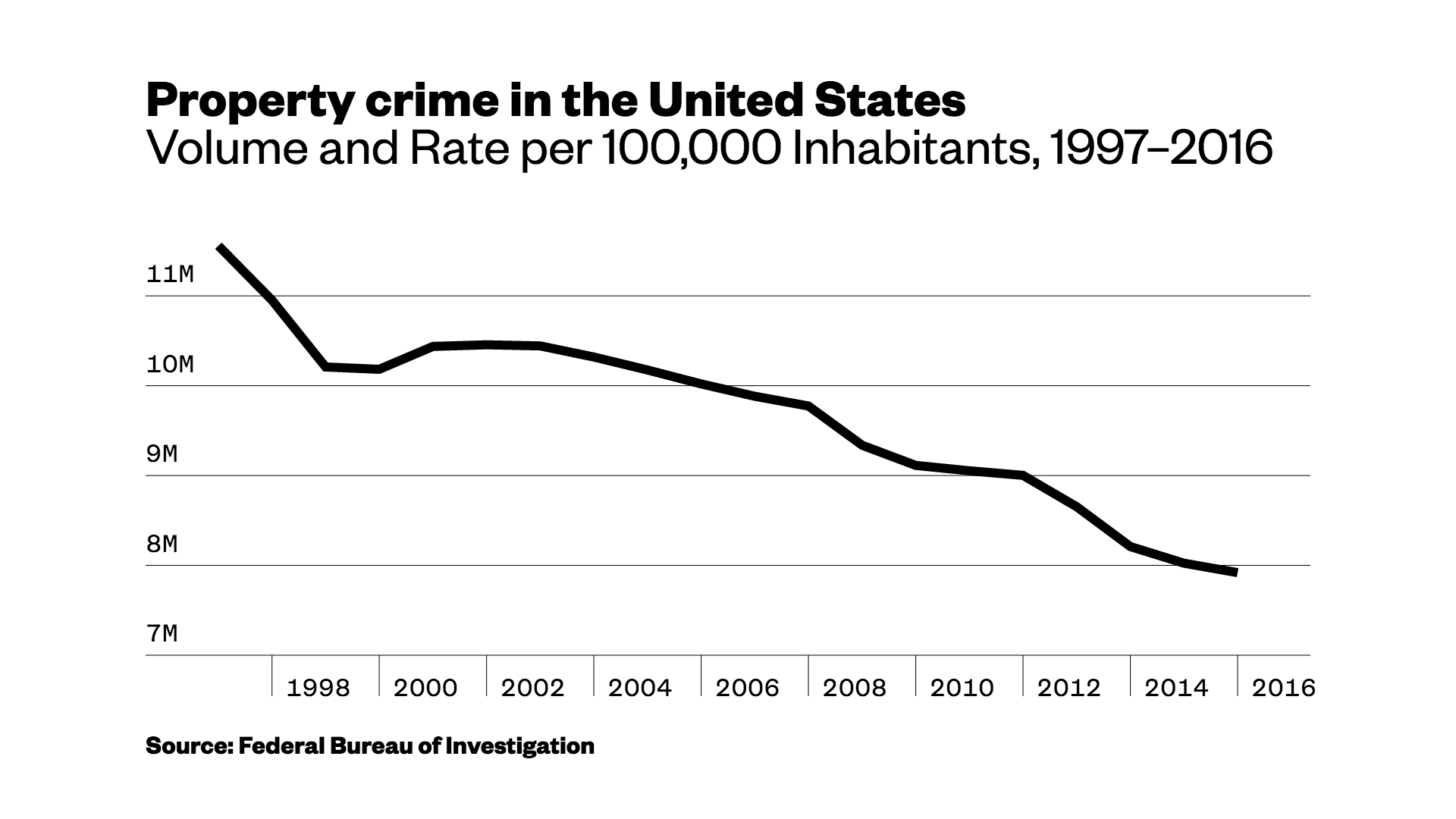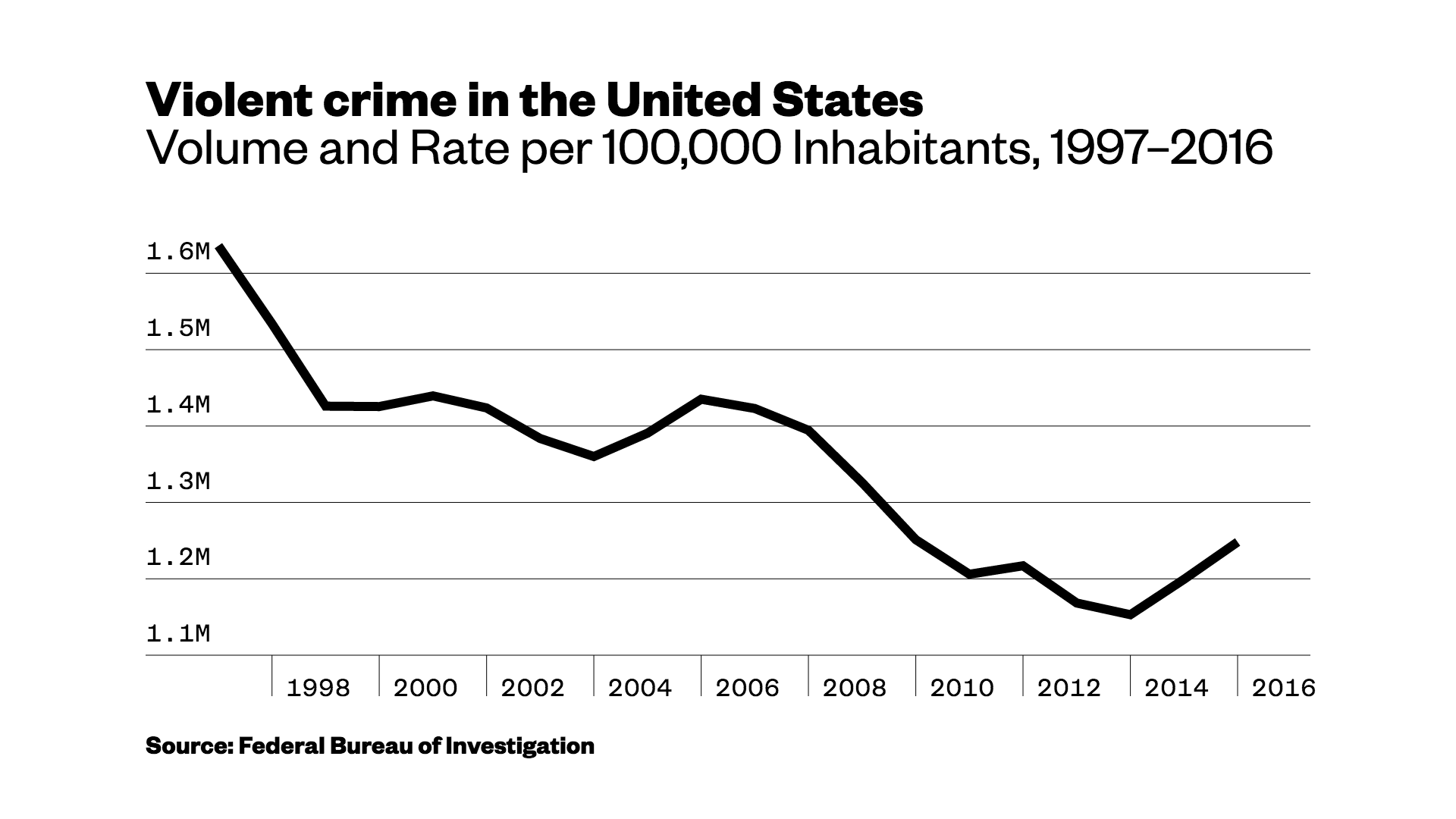Attorney General Jeff Sessions and President Donald Trump haven’t held back on apocalyptic language like “American carnage” to describe the uptick in violent crime in some major cities over the last few years.Although the latest FBI crime statistics do show an increase in violent crime, the numbers remain near historically low levels. The data paints a more nuanced picture of America than the Trump administration touts.Here’s what the data shows: But experts caution against reading too much into such short-term changes.“Two years are not a reliable trend,” said James Alan Fox, a professor of criminology at Northeastern University. “In the backdrop, homicide rates in this country are at a half-century low.” For an increase to be considered a “trend” rather than an aberration, according to Fox, it would have to be observed over a period of three or more years.A recent report by the Brennan Center, a nonpartisan think tank, parsed crime data from 2017 and predicted that homicides will actually decline by 2.5 percent by the end of the year, which would reverse the two-year increase shown in the FBI’s data. The Brennan Center’s projections mirror what many criminologists have said all along.Read: The White House is already skewing crime stats to fit Trump’s agendaOn the other hand, some experts caution against downplaying the data. Daniel Richman, a former federal prosecutor and current professor at Columbia Law School, worries that the Brennan Center’s objective is to push back against the Trump administration.“Neither side has this right,” Richman said. “Those with responsibility for public safety need to be clear-eyed in what’s happening, and there are risks in underestimating the problem … because people are dying.”Richman and his colleague Jeffrey Fagan, also a Columbia law professor and director of that institution’s Center for Crime, Community and Law, recently published a study titled “Understanding Recent Spikes and Longer trends in American Murders” that sought to weigh some of the factors that could be driving the uptick in violent crime in certain cities.The geographical distribution of violent crime fluctuations over the last two years reflected in the FBI data also fits with what Richman’s study suggests: that a small handful of cities — where a confluence of factors like growing economic inequality and a widening breach in trust between communities and law enforcement — created fertile conditions for violence and largely drove the increase in violent crime. In 2015, for example, Chicago, Baltimore, and Washington, D.C., accounted for more than half the homicides across the nation’s 50 biggest cities.
But experts caution against reading too much into such short-term changes.“Two years are not a reliable trend,” said James Alan Fox, a professor of criminology at Northeastern University. “In the backdrop, homicide rates in this country are at a half-century low.” For an increase to be considered a “trend” rather than an aberration, according to Fox, it would have to be observed over a period of three or more years.A recent report by the Brennan Center, a nonpartisan think tank, parsed crime data from 2017 and predicted that homicides will actually decline by 2.5 percent by the end of the year, which would reverse the two-year increase shown in the FBI’s data. The Brennan Center’s projections mirror what many criminologists have said all along.Read: The White House is already skewing crime stats to fit Trump’s agendaOn the other hand, some experts caution against downplaying the data. Daniel Richman, a former federal prosecutor and current professor at Columbia Law School, worries that the Brennan Center’s objective is to push back against the Trump administration.“Neither side has this right,” Richman said. “Those with responsibility for public safety need to be clear-eyed in what’s happening, and there are risks in underestimating the problem … because people are dying.”Richman and his colleague Jeffrey Fagan, also a Columbia law professor and director of that institution’s Center for Crime, Community and Law, recently published a study titled “Understanding Recent Spikes and Longer trends in American Murders” that sought to weigh some of the factors that could be driving the uptick in violent crime in certain cities.The geographical distribution of violent crime fluctuations over the last two years reflected in the FBI data also fits with what Richman’s study suggests: that a small handful of cities — where a confluence of factors like growing economic inequality and a widening breach in trust between communities and law enforcement — created fertile conditions for violence and largely drove the increase in violent crime. In 2015, for example, Chicago, Baltimore, and Washington, D.C., accounted for more than half the homicides across the nation’s 50 biggest cities. While crime rate data for local agencies aren’t available yet, it’s possible to draw some conclusions based on what the FBI has published so far, which shows crime statistics and rates by state.In Illinois, for example, murders increased by nearly 40 percent; 754 homicides were recorded in 2015, then up to 1,054 in 2016, according to the FBI’s data. The staggering upstick is driven largely by Chicago, which has been battling a devastating surge in gun violence for the past two years. Illinois accounted for 6 percent of all murders nationwide in 2016. According to the Chicago Tribune, there were 789 homicides in Chicago during 2016. Using that figure, Chicago would account for about 75 percent of all murders in the state.Violent crime more generally surged by more than 12 percent in Illinois.Read: This is the first database that tracks America’s criminal copsMeanwhile, in Maryland — home to Baltimore, another major city whose skyrocketing gun violence has attracted the national spotlight — homicide rates dropped by more than 10 percent, according to the FBI stats. Violent crime rose slightly, by less than 1 percent.Still, Sessions isn’t taking any chances. In a statement released Monday in response to the FBI’s 2016 data, the attorney general stuck to his black-and-white narrative.“For the sake of all Americans, we must confront and turn back the rising tide of violent crime. And we must do it together,” said Sessions in the statement. “The Department of Justice is committed to working with our state, local, and tribal partners across the country to deter violent crime, dismantle criminal organizations and gangs, stop the scourge of drug trafficking, and send a strong message to criminals that we will not surrender our communities to lawlessness and violence.”
While crime rate data for local agencies aren’t available yet, it’s possible to draw some conclusions based on what the FBI has published so far, which shows crime statistics and rates by state.In Illinois, for example, murders increased by nearly 40 percent; 754 homicides were recorded in 2015, then up to 1,054 in 2016, according to the FBI’s data. The staggering upstick is driven largely by Chicago, which has been battling a devastating surge in gun violence for the past two years. Illinois accounted for 6 percent of all murders nationwide in 2016. According to the Chicago Tribune, there were 789 homicides in Chicago during 2016. Using that figure, Chicago would account for about 75 percent of all murders in the state.Violent crime more generally surged by more than 12 percent in Illinois.Read: This is the first database that tracks America’s criminal copsMeanwhile, in Maryland — home to Baltimore, another major city whose skyrocketing gun violence has attracted the national spotlight — homicide rates dropped by more than 10 percent, according to the FBI stats. Violent crime rose slightly, by less than 1 percent.Still, Sessions isn’t taking any chances. In a statement released Monday in response to the FBI’s 2016 data, the attorney general stuck to his black-and-white narrative.“For the sake of all Americans, we must confront and turn back the rising tide of violent crime. And we must do it together,” said Sessions in the statement. “The Department of Justice is committed to working with our state, local, and tribal partners across the country to deter violent crime, dismantle criminal organizations and gangs, stop the scourge of drug trafficking, and send a strong message to criminals that we will not surrender our communities to lawlessness and violence.”
Advertisement
- Violent crime increased by 4 percent between 2015 and 2016 but is still 18 percent lower than it was 10 years ago.
- Murder and non-negligent manslaughter rose by nearly 9 percent between 2015 and 2016. That’s 6 percent lower than it was a decade ago.
- Rape increased by nearly 5 percent.
- Property crimes are down by 1 percent and are at the lowest they’ve been in the last 50 years.
- Violent crime rates per 100,000 people increased most significantly in the West, where Arizona and Hawaii saw the biggest increases.
- The Midwest, particularly Illinois and South Dakota, saw the next-largest increase.
- In the Northeast, violent crime rates dipped slightly in 2016.

Advertisement
Advertisement
